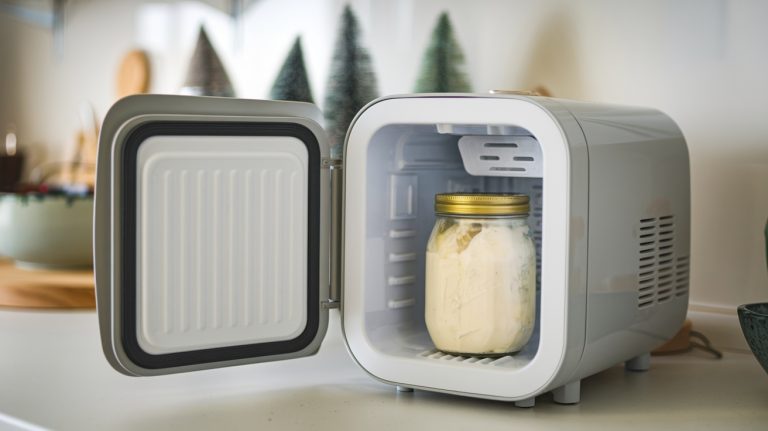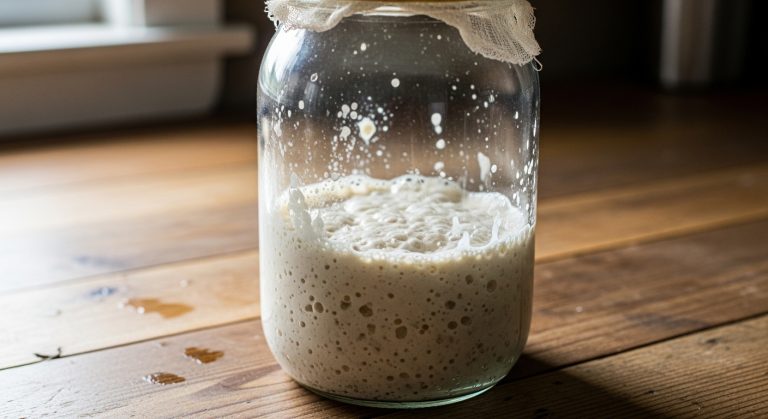Low Sodium Sourdough: A Heart-Healthy Baking Guide
You can make low sodium sourdough by using bread flour, filtered water, and a salt reduction or omission, relying on natural fermentation to build flavor and texture without added salt.
This approach supports heart health, improves mineral absorption, and enhances digestibility through fermentation. Control temperature, hydration, and starter activity to maximize flavor complexity and maintain dough structure.
For a balanced, tangy loaf rich in nutrients and gut-friendly properties, explore how fermentation and ingredients combine for the best results.
Key Takeaways
- Low sodium sourdough reduces salt intake, supporting cardiovascular health and better mineral absorption like magnesium and calcium.
- Use bread flour, filtered water, and minimal or no salt in the starter and dough to maintain low sodium levels.
- Precise measurement and controlled fermentation at 68–70°F enhance flavor development without added salt.
- Fermentation produces organic acids and prebiotics, improving digestibility, nutrient availability, and natural tangy flavor.
- Baking in a covered vessel at 450°F after shaping and scoring ensures a crispy crust and soft crumb texture.
Step-by-Step Low Sodium Sourdough Recipe
| Step | Ingredient / Action | Details & Tips |
|---|---|---|
| 1. Starter | 100g active sourdough starter | Fed within last 6–8 hours, no salt |
| 2. Water | 350g filtered water | Room temperature, no added sodium |
| 3. Flour | 500g bread flour (or mix with whole wheat) | Organic, avoid enriched flour |
| 4. Salt (optional) | 5g (~1% flour weight) | Can omit or replace with herbs |
| 5. Mixing | Combine starter + water, then add flour gradually | Creates uniform, hydrated dough |
| 6. Bulk Fermentation | 68–70°F, 3–12 hours | Stretch & fold every 30 minutes for 2 hours |
| 7. Shaping | Form into round or oblong loaf | Rest 20–30 minutes before final rise |
| 8. Final Proof | 1–2 hours at room temp, or overnight in fridge | Dough should nearly double |
| 9. Baking | Preheated Dutch oven at 450°F | 20 min covered, 20 min uncovered |
| 10. Cooling | Rest loaf on wire rack | Wait at least 1 hour before slicing |
Benefits of Reducing Sodium in Sourdough
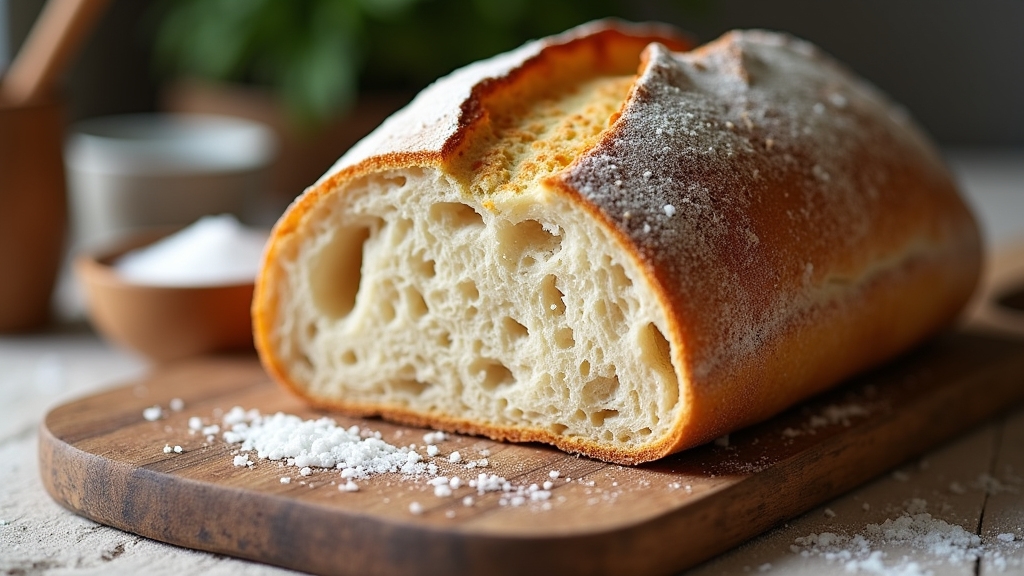
When you reduce sodium in sourdough, you actively support cardiovascular health by lowering blood pressure, a key factor in preventing heart disease. Lower sodium intake decreases salt-related hypertension risks, easing the burden on your kidneys and indirectly protecting your heart. Using precise measurements with a digital baking scale can help maintain consistent sodium levels in your recipes.
Additionally, whole grain low sodium sourdough provides fiber that helps lower cholesterol, further benefiting cardiovascular function. The fermentation process enhances mineral absorption—especially magnesium—which plays an essential role in regulating blood pressure.
The natural fermentation process also reduces reliance on chemical preservatives, with specific lactobacilli strains producing acids that inhibit mold growth, ensuring a more natural product with fewer additives natural fermentation.
By choosing low sodium sourdough, you also reduce the risk of inflammation and water retention linked to excess salt. This evidence-based approach aligns with dietary guidelines recommending less than 2,300 mg of sodium daily.
Making low sodium sourdough a smart, heart-healthy bread option ensures you don’t compromise taste or fermentation quality.
Essential Ingredients for Low Sodium Sourdough
Although reducing sodium is essential for health, selecting the right ingredients guarantees your low sodium sourdough maintains excellent texture and flavor.
Choose bread flour for strong gluten and avoid pre-salted or enriched flours. This helps create a sturdy dough without adding unwanted sodium. The use of high-quality flours in sourdough mixes contributes to a better texture and flavor.
Use filtered water without added sodium, ideally at room temperature, to support fermentation. Clean water ensures the starter remains active and free from extra salts.
Keep salt low—around 1% of flour weight—to balance flavor without compromising dough strength. This minimal amount enhances taste while keeping sodium intake down.
Your starter needs only flour and water, with no salt, to keep sodium minimal and fermentation active. Maintaining regular feedings is crucial so the starter stays active and bubbly.
| Ingredient Type | Recommendation |
|---|---|
| Flour | Bread flour, organic, avoid enriched |
| Water | Filtered, room temp, no added sodium |
| Salt & Additives | 1% salt, unsalted oils, natural herbs |
These choices preserve sourdough quality while reducing sodium effectively.
Step-by-Step Process to Prepare Low Sodium Sourdough
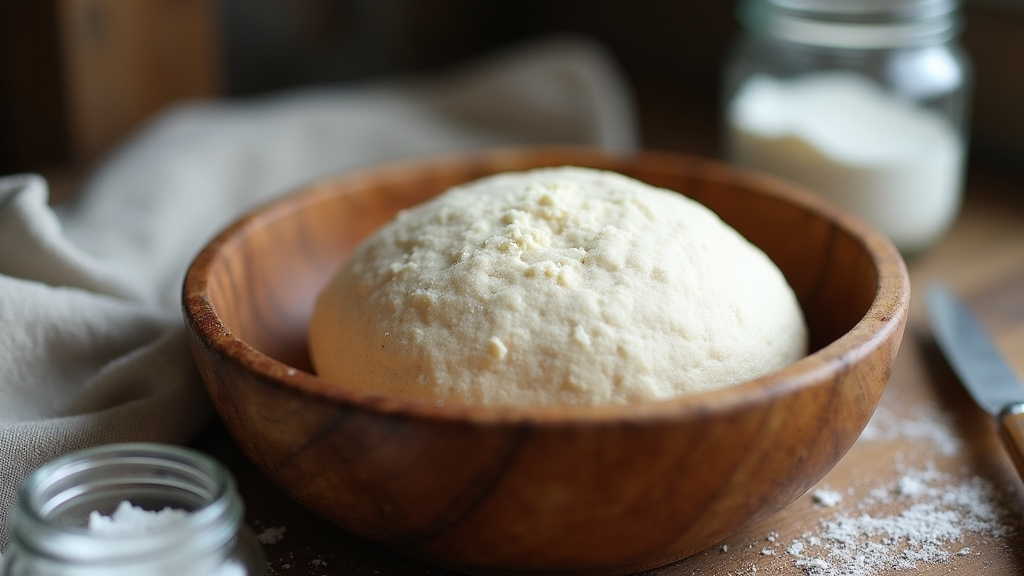
You’ll start by preparing your ingredients carefully, using an active sourdough starter combined with warm water and minimal salt to support fermentation without excess sodium. This natural leavening process relies on wild yeasts and bacteria to develop flavor and texture.
Next, you’ll mix the dough until it reaches the right consistency before allowing it to rise at room temperature until doubled. Using a dough hook for this step is recommended as it allows for quicker, more consistent mixing with a dough hook.
This step ensures proper yeast activity, which is crucial for the bread’s texture and flavor.
Following these steps precisely helps maintain texture and flavor while keeping sodium levels low.
Ingredient Preparation
Since controlling sodium content is essential in low sodium sourdough, you should carefully select and measure each ingredient to maintain flavor without compromising dough structure.
Start by choosing low-sodium or no-salt options, such as fine sea salt in minimal amounts or omitting it entirely. Use filtered or no-sodium bottled water to avoid hidden sodium sources. Maintaining an active sourdough starter is crucial because it is the natural leavening agent responsible for developing flavor and rise. Using accurate measurement tools ensures precise ingredient control for consistent results.
Incorporate high-protein bread flour or a blend with whole wheat for ideal gluten development and nutrition.
Follow these steps for precise ingredient preparation:
- Weigh all ingredients with a digital scale to accurately control sodium levels.
- Mix the sourdough starter thoroughly with water first, creating a uniform slurry before adding dry ingredients.
- Add flour gradually while stirring to ensure even hydration and prevent clumps, adjusting water slightly to balance dough consistency.
Dough Rising Process
When you start the dough rising process for low sodium sourdough, controlling temperature and timing is essential to achieve peak fermentation. Bulk fermentation occurs ideally at 68–70°F (20–21°C), lasting 3–12 hours. During this time, perform stretching and folding “turns” every 30 minutes over the first few hours to develop gluten and structure. This careful temperature control also helps create an open crumb structure characteristic of well-fermented sourdough.
You’ll notice the dough puff up and nearly double in volume. Cover it with lightly oiled plastic wrap to retain moisture.
Incorporate salt carefully to slow fermentation and strengthen gluten without excess sodium. Use the stretch and fold technique 3–4 times during the first two hours to build structure and trap air bubbles.
| Temperature (°F) | Rise Time (Hours) |
|---|---|
| 68–70 | 3–12 |
| 80 | 2–4 |
| Below 68 | 10–12+ |
| Room Temp Avg | 3–4 |
This process deepens flavor and develops gluten for a strong loaf.
How Fermentation Enhances Flavor Without Salt?
Although salt traditionally enhances bread flavor, fermentation plays an essential role in developing complex tastes without it.
During fermentation, enzymes break down starches into sugars, boosting sweetness and flavor depth. Controlling fermentation temperature is key to balancing acid production and flavor complexity.
Fermentation unleashes enzymes that transform starches into sugars, enriching sweetness and deepening flavor profiles.
The microbial balance in your sourdough starter produces organic acids and volatile compounds that add richness, compensating for reduced salt.
To optimize flavor without salt, focus on controlling fermentation time and temperature to maximize enzyme activity and release fermentable sugars.
Maintaining a ripe starter helps balance lactic acid bacteria and wild yeast, ensuring desirable flavor profiles.
Utilizing autolysis combined with fermentation enhances enzymatic breakdown, improving flavor precursors and dough extensibility. This process also helps develop a strong gluten network, essential for proper dough structure and flavor retention during baking.
Nutritional Advantages of Low Sodium Sourdough Bread
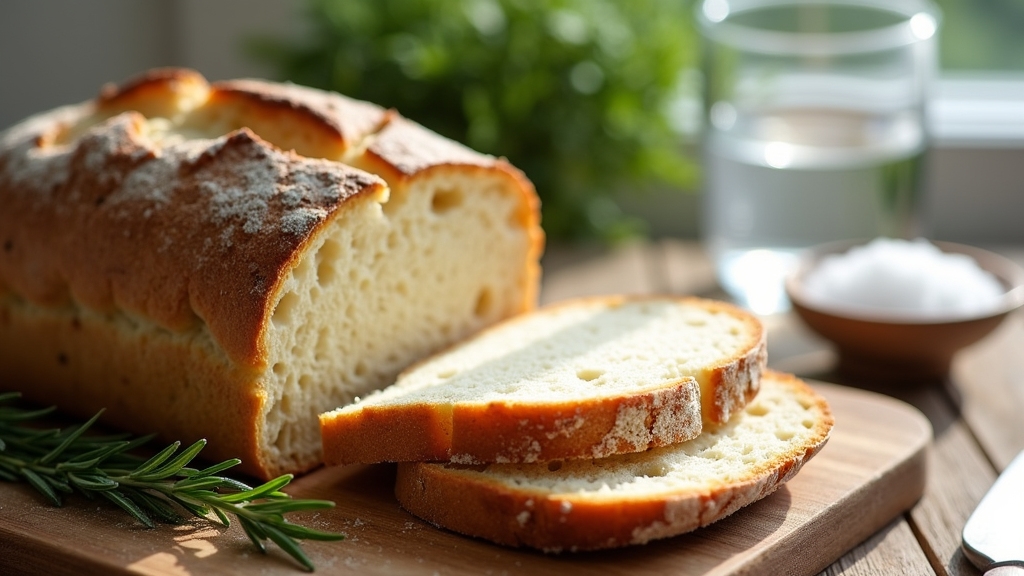
You’ll benefit from low sodium sourdough by reducing your salt intake, which supports cardiovascular health and lowers blood pressure risk.
Its fermentation process enhances nutrient absorption, boosting minerals like magnesium and iron essential for metabolism. This process also makes sourdough unique compared to regular bread made with commercial yeast, thanks to its living starter.
Plus, the bread’s resistant starch promotes better digestive health by feeding beneficial gut bacteria.
This resistant starch also helps ease digestion, making sourdough a gentle option for your digestive system.
Reduced Sodium Benefits
How does lowering sodium in your sourdough bread benefit your health? Reducing sodium intake supports heart health by lowering blood pressure and decreasing risks of stroke and heart failure. Using a sourdough starter that is carefully balanced can also influence the final sodium content in the bread.
It also enhances blood sugar regulation, aiding insulin sensitivity and minimizing glucose spikes.
Additionally, reduced sodium improves digestive comfort by decreasing gut inflammation and bloating. Most sodium intake comes from processed foods, so choosing low sodium sourdough helps cut down excess sodium consumption.
Here are three key benefits of choosing low sodium sourdough bread:
- Cardiovascular Support: Helps maintain balanced mineral levels and fits heart-healthy dietary guidelines.
- Metabolic Health: Promotes better potassium balance and reduces sodium interference with glucose metabolism.
- Digestive Wellness: Lowers osmotic stress in the gut and encourages beneficial microbiome activity.
Enhanced Nutrient Absorption
Lowering sodium in sourdough not only supports heart and digestive health but also enhances how your body absorbs essential nutrients. The fermentation process reduces phytic acid—a compound that binds minerals like iron, magnesium, zinc, and calcium—by over 70%, notably increasing their bioavailability.
This means your body can better absorb these minerals vital for bone strength, immune function, and metabolism. Additionally, sourdough fermentation boosts antioxidant levels by releasing bound phenolic compounds, which help combat oxidative stress. It also promotes the synthesis of certain B vitamins, enriching your bread’s nutritional profile.
Moreover, the natural fermentation process improves digestibility by breaking down gluten and complex carbohydrates, making the bread easier on the digestive system. Selecting quality ingredients and tools, such as a beveled edge peel, can further enhance your homemade sourdough baking experience.
Improved Digestive Health
Why does choosing low sodium sourdough bread benefit your digestive health? Low sodium sourdough offers several advantages that support your gut function and comfort.
First, it markedly reduces FODMAP content—fermentable sugars that often cause bloating and discomfort—making it ideal if you have IBS. Additionally, sourdough neutralizes phytic acid in wheat bran, which helps reduce digestive discomfort and improves nutrient absorption. The fermentation process also acts as a prebiotic, promoting beneficial gut bacteria that aid digestion.
Second, sourdough fermentation produces prebiotics and resistant starch, which nourish beneficial gut bacteria. This promotes a balanced microbiome linked to reduced inflammation and better digestion.
Third, the fermentation process lowers the bread’s glycemic index, leading to slower sugar absorption and more stable blood glucose levels. This supports overall digestive and metabolic health.
Flavor and Texture Characteristics of Low Sodium Variants
Although reducing sodium in sourdough lessens its typical salty flavor, you’ll notice the natural tanginess from the starter becomes more pronounced, offering a milder but distinct taste profile. This shift highlights fermentation-derived organic acids, creating a subtle yet noticeable increase in sourness.
Reducing sodium reveals the sourdough’s natural tang, enhancing its mild, distinct, and pleasantly sour character.
Using low sodium sea salt can introduce delicate mineral notes, slightly altering flavor complexity without overwhelming the palate.
Texture-wise, lower sodium weakens gluten strength, producing a softer crumb and potentially stickier dough. You might see reduced dough stability and faster staling due to altered fermentation and gas retention.
Sea salt substitutions can help maintain elasticity by reinforcing gluten networks, partially offsetting these effects.
For optimal slicing of your low sodium sourdough, consider using a wavy edge blade to handle the crust without crushing the softer crumb.
Practical Tips for Maintaining a Healthy Sourdough Starter
To keep your sourdough starter healthy and active, you need a consistent feeding routine that balances timing, ingredients, and environment. Feed it at least once daily, ideally at the same time, using a stable flour blend and a feeding ratio like 1:3:4 (starter:water:flour). Adjust frequency based on storage temperature: daily at room temperature or weekly in the fridge.
Follow these practical tips:
- Use organic, unbleached flour and filtered water to protect microbial viability and avoid chlorine inhibition.
- Maintain hygiene by cleaning glass jars thoroughly after each feeding, using clean utensils, and avoiding crevices that trap dried starter.
- Monitor activity visually and by aroma—bubbling and a pleasant sour smell indicate health; off smells or collapsed starters require more frequent feedings. Feeding your starter consistently at the same time daily promotes a predictable, healthy starter.
These practices ensure a resilient, low sodium sourdough starter.
Variations and Customizations for Low Sodium Recipes
When you reduce sodium in sourdough recipes, you’ll need to modify other ingredients and techniques to maintain flavor, texture, and rise. Replace some salt with flavor enhancers like garlic or onion powder, herbs such as thyme, or small amounts of Swiss cheese to boost taste without adding sodium.
Using herbs and spices like garlic powder, onion powder, basil, oregano, parsley, or rosemary during the initial mixing can add depth without extra salt.
Adjust flour blends by combining whole wheat with bread flour to improve texture and gluten strength, compensating for salt’s typical function. Use precise hydration and consider no-knead methods to develop gluten slowly. The dough should be slightly wet but not dry, and allowing it to rest before shaping enhances crust and texture.
Fermentation benefits from minimal instant yeast alongside your starter and controlled water temperature to ensure proper rise. Incorporate acidifiers like honey and olive oil to improve moisture and shelf life. Letting the dough rise for about 8 to 24 hours in a warm place helps develop flavor and structure while keeping sodium low.
Finally, customize baking shapes and scoring to enhance presentation and crust formation despite lower sodium levels. Baking in a preheated covered vessel, such as a Dutch oven, at 450°F helps create a crispy crust even with reduced salt.
Frequently Asked Questions
How Should Low Sodium Sourdough Be Stored to Maintain Freshness?
You should store your sourdough bread fully cooled, wrapped in a linen or cotton bag to balance breathability and moisture, keeping the crust crisp and crumb fresh. Avoid plastic bags at room temperature, as they trap moisture and soften crust.
For longer storage, freeze the loaf wrapped tightly in plastic or foil inside an airtight bag. Thaw slowly to preserve texture.
Use a wooden breadbox or cloth bag for short-term storage to maintain freshness and prevent mold.
Can Low Sodium Sourdough Be Frozen and Reheated Effectively?
Freezing low sodium sourdough is like pressing pause on freshness—you can lock in its texture and flavor without harm. Just cool it completely, wrap it tightly in foil, and seal in an airtight bag.
When reheating, spritz with water and warm in a 350°F oven to revive its crusty charm. You’ll avoid sogginess and freezer burn, enjoying near-fresh bread for up to two months with minimal quality loss.
What Are Common Troubleshooting Tips for Dense Low Sodium Sourdough?
If your sourdough turns out dense, first check for under-proofing—allow the dough enough time to rise until the indentation slowly fills halfway.
Strengthen your starter by feeding it regularly and ensuring it’s active.
Increase dough hydration slightly, aiming for around 70%, and use stretch-and-folds to develop gluten.
Avoid over-fermentation by monitoring timing closely.
Finally, bake with steam to improve oven spring and crust formation, enhancing crumb openness and lightness.
How Does Low Sodium Sourdough Compare in Price to Commercial Bread?
When you reach for low sodium sourdough, expect to pay more than for commercial bread—usually $4–$6 per loaf compared to $2–$4. That price jump reflects longer fermentation, higher-quality ingredients, and artisanal processes.
While commercial breads keep costs low with additives and mass production, low sodium sourdough offers fewer additives and nutritional benefits—making it a premium choice worth the extra cost if you value health over budget.
Are There Any Specific Health Conditions That Particularly Benefit From Low Sodium Sourdough?
You’ll find low sodium sourdough especially beneficial if you manage hypertension or cardiovascular disease, as it supports blood pressure control and heart health.
It also aids those with metabolic conditions like diabetes by stabilizing blood sugar and improving insulin sensitivity.
If you have gastrointestinal issues such as IBS, its fermentation reduces FODMAPs, easing digestion.
Plus, it enhances mineral absorption, benefiting bone health and mineral deficiency conditions.
Start Your Low Sodium Sourdough Journey Today
By choosing low sodium sourdough, you’re not just cutting salt—you’re unveiling a world where fermentation deepens flavor naturally.
Imagine savoring bread that supports heart health without sacrificing taste or texture.
As you master these techniques, you’ll discover how a simple shift can transform your baking and wellbeing.
Ready to experience bread that’s both wholesome and delicious? The journey starts with one mindful loaf—will you take the step?


